
Content sponsored by:
Life Rainbow
Bacillus licheniformis-Fermented Products Improve Growth Performance and Intestinal Gut Morphology in Broilers under Clostridium perfringens Challenges (Extract)
Published: February 24, 2022
By: Life Rainbow Biotech
Antibiotics in feed have been effective in controlling the prevalence of necrotic enteritis in broilers. However, the occurrence and severity of C. perfringens-induced necrotic enteritis has increased over the years due to the banning of the use of antibiotics in food-producing animals. Thus, the poultry industry is in urgent need of alternative strategies to prevent necrotic enteritis in broilers.
Probiotics have become the ideal alternative to antibiotic growth promoters. Bacillus licheniformis, a gram-positive and endospore-forming probiotic strain exhibits in vitro antibacterial activity against C. perfringens through the production of the antibacterial cyclic lipopeptide surfactin. Our previous studies have shown that surfactin isolated from B. licheniformis-fermented products can suppress the growth of C. perfringensin vitro. Furthermore, B. licheniformis is able to mitigate C. perfringens-induced necrotic enteritis and ameliorate growth performance in broilers.
The current study investigated the surfactin levels of Bacillus licheniformis in solid-state fermentation evaluate the effects of B. licheniformis-fermented products on growth performance and intestinal morphology in broilers exposed to C. perfringens.
Animal Studies
1. One-day-old healthy male broiler chicks (Ross 308) on day 1, 60 chicks were randomly allocated into 12 cages (4 groups×3 replications, each replication included 5 chicks) in a completely randomized design.
2. The experimental diets consisted of: (1) a basal diet plus C. perfringens challenge as control; (2) a basal diet plus C. perfringens challenge and 0.5 g/kg enramycin from days 1 to 21 and 1.2 g/kg enramycin from days 22 to 35; (3) a basal diet plus C. perfringens challenge and 1 g/kg of B. licheniformis-fermented products (2.5×108 CFU/g of feed); and (4) a basal diet plus C. perfringens challenge and 2 g/kg of B. licheniformis-fermented products (5.0×108 CFU/g of feed).
3. The birds were orally gavaged with 1 mL (1×108 CFU/mL) of C. perfringens at 19, 20, and 21 days of age.
4. Their growth performance, including average body weight, average daily gain weight, average daily feed intake, and feed conversion ratio, were recorded and calculated from days 1 to 35.

Effect of the Dietary B. licheniformis-fermented Product Supplementation on Growth Performance in Broilers Exposed to C. perfringens
In Table 1, After the C. perfringens challenge, the supplementation of enramycin in the feed of chickens increased their body weight at 21 days of age compared with other treatments (P< 0.05). The dietary supplementation of 2 g/kg of B. licheniformis-fermented products in broilers also increased their body weight at 21 days of age compared with the control group (P< 0.05). Similar results were also found in broilers at 35 days of age (P< 0.05). Broilers fed enramycin had a higher average daily weight gain between days 1 and 21 and this was also significant over the whole trial period (days 1 to 35) compared with other treatments (P< 0.05). The supplementation of 2 g/kg of B. licheniformis-fermented products in the feed of chickens also resulted in a significant increase in the average daily weight gain between days 1 and 21 and this was also significant over the whole trial period (days 1 to 35) compared with the control group (P< 0.05). The supplementation of enramycin in the feed of chickens resulted in a significantly reduced feed conversion ratio between days 1 and 21 compared with the control group (P< 0.05). Similarly, the supplementation of the broiler diet with B. licheniformis-fermented products (1 and 2 g/kg) also decreased feed conversion ratio between days 1 and 21 (P< 0.05). Broilers supplemented with enramycin had a lower feed conversion ratio over the whole trial period (days 1 to 35) compared with other treatments (P< 0.05).
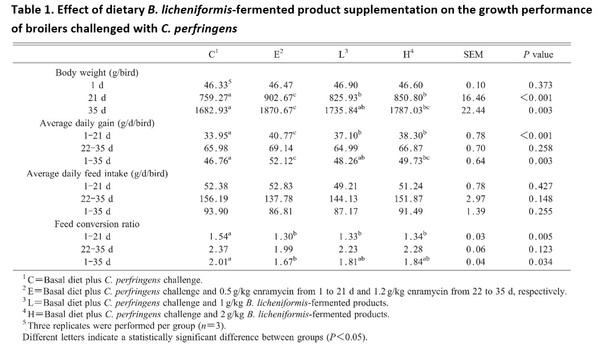
Effect of the Dietary B. licheniformis-Fermented Product Supplementation on Intestinal Morphology and Splenic Gene Expression in Broilers Exposed to C. perfringens
In Table 2, after 22 days of feeding, enramycin treatment efficiently mitigated the duodenal and jejunal damage caused by C. perfringens compared with the control group (P< 0.05). Similar to the effect of enramycin, the dietary supplementation of 2 g/kg of B. licheniformis-fermented products relieved the C. perfringens-induced necrotic lesions in the duodenum and jejunum of broilers (P< 0.05). After feeding the diets for 35 days, broilers fed with enramycin and B. licheniformis-fermented products (1 and 2 g/kg) had significantly reduced lesion scores in the jejunum compared with the control group (P< 0.05). Enramycin mitigated the C. perfringens-induced necrotic lesions in the ileum of broilers compared with the control group (P< 0.05).
The effect of dietary B. licheniformis-fermented product supplementation on the morphology of the small intestine of broilers under C. perfringens challenge is shown in Table 3, Enramycin and B. licheniformis-fermented products (1 and 2 g/kg) had a similar significant effect in improving villus length in the duodenum and jejunum at 21 days of age (P< 0.05). The ratio of villus length to crypt depth was increased in the duodenum in broilers fed with enramycin and B. licheniformis-fermented products (1 and 2 g/kg) at 21 days of age compared with the control group (P< 0.05). After 35 days, broilers supplemented with enramycin and B. licheniformis-fermented products (1 and 2 g/kg) had longer villus in the jejunum and ileum compared with the other treatments (P< 0.05). B. licheniformis-fermented products (2 g/kg) reduced the jejunal and ileal crypt depth at 35 days of age compared with the other treatments (P< 0.05). The ratio of villus length to crypt depth was increased in the jejunum and ileum in broilers fed with enramycin and 2 g/kg of B. licheniformis-fermented products at 35 days of age compared with the other treatments (P< 0.05).
The effect of dietary B. licheniformis-fermented product supplementation on mRNA expression in spleens of broilers under C. perfringens challenge is shown in Table 4. The cox2 mRNA expression was higher in broilers fed with B. licheniformis-fermented products (1 and 2 g/kg) compared with the enramycin group (P< 0.05). B. licheniformis-fermented products (2 g/kg) significantly increased the ifnγ and il-1β mRNA expression in broilers of 22 days of age compared with the control group (P< 0.05). Enramycin significantly reduced the ifnγ mRNA expression in broilers of the same age compared with the control group (P< 0.05). After 35 days of feeding, the inos mRNA expression was induced in broilers fed with B. licheniformis-fermented products (1 g/kg) (P< 0.05). B. licheniformis-fermented products (1 and 2 g/kg) significantly induced the il-1β mRNA expression in broilers of 35 days of age compared with the control group (P< 0.05).
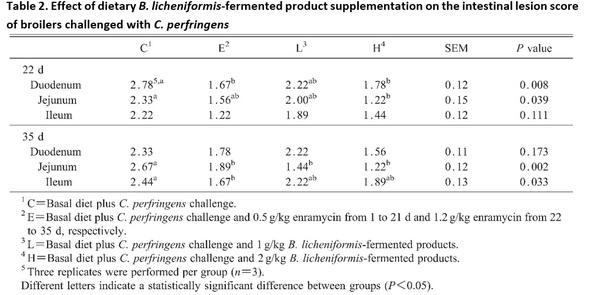
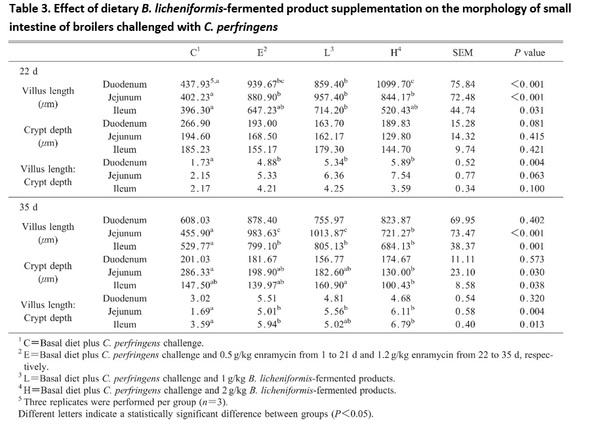
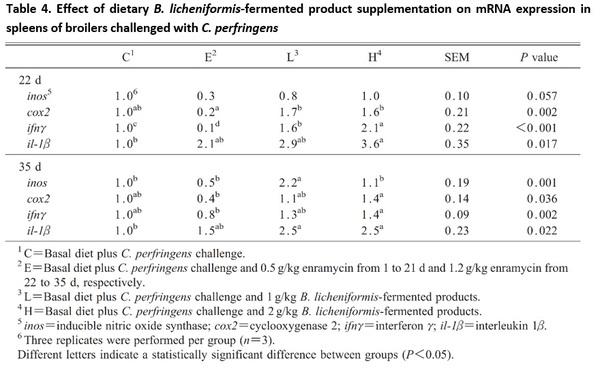
Dose-Response Between the B. licheniformis-Fermented Product Concentration, Growth Performance, Lesion Score, and Intestinal Morphology in Broilers Exposed to C. perfringens
The results of linear and quadratic dose-response of dietary B. licheniformis-fermented products on broilers challenged with C. perfringens are shown in Table 5. The B. licheniformis-fermented product concentration was linearly correlated with the body weight, average daily weight gain, and lesion score in broilers under C. perfringens challenge (P< 0.05). Besides, the concentration of B. licheniformis-fermented products was linearly correlated with the villus length and the ratio of villus length to crypt depth in broilers of 22 days of age, particularly in the duodenum and jejunum (P< 0.05). The crypt depth and the ratio of villus length to crypt depth were linearly associated with the B. licheniformis-fermented product concentration in broilers of 35 days of age, particularly in the jejunum and ileum (P< 0.05). The quadratic dose-response of dietary B. licheniformis-fermented products was also found in the villus length of jejunum and ileum in broilers of 22 and 35 days of age (P< 0.05).
In conclusion, these observations demonstrate that B. licheniformis-fermented products improve growth performance and gut morphology in broilers under C. perfringens challenge. B. licheniformis-fermented products may have the potential to be used as alternatives to antibiotic growth promoters for preventive treatments against C. perfringens in broilers and may be useful feed additives replacing banned infeed antibiotics.
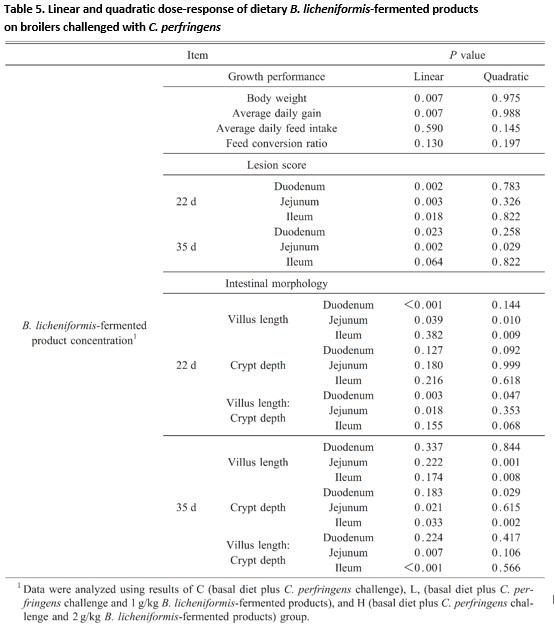
References
Cheng Y. H., Y. B. Horng, A. Dybus and Y. H. Yu. 2021. Bacillus licheniformis-Fermented Products Improve Growth Performance and Intestinal Gut Morphology in Broilers under Clostridium perfringens Challenges. J Poult Sci. 58: 30–39.
Related topics:
Influencers who recommended :
David JiangRecommend
Comment
Share

Would you like to discuss another topic? Create a new post to engage with experts in the community.
.jpg&w=3840&q=75)